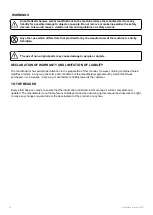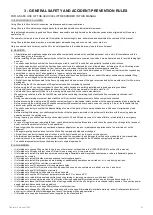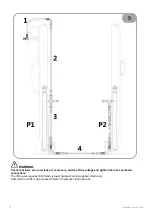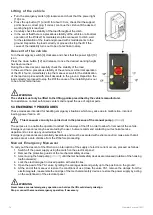
3 - GENERAL SAFETY AND ACCIDENT-PREVENTION RULES
FOR A SAFE USE OF THE VEHICLE LIFT DESCRIBED IN THIS MANUAL
THE FOLLOWING IS ALLOWED:
Using lift only to lift vehicles for inspection, maintenance and/or repair operations.
Using lift only to lift vehicles respecting capacity limits and loads distribution indicated in this manual.
Only authorized personnel, in good health conditions, responsible and duly trained on the allowed uses and risks originated by lift use may
operate the lift.
The operator is allowed to use the vehicle lift only after he has thoroughly read, understood and assimilated the contents of this manual.
Using lift only inside closed premises, protected against atmospheric agents such as: rain, snow, wind, etc.
Only one operator at a time may use the lift in the safety position in the indicated area, close to the control panel
IS REQUIRED:
•
Lift installation and maintenance operations shall be compulsorily carried out by qualified personnel only, and in full compliance with the
instruc-tions given in this manual.
•
Before installing lift, you shall compulsorily check that the premises where you wish to position it are well aerated and lit. (avoid blinding light
sources).
•
You shall compulsorily check that the floor where you wish to install lift is solid, flat, and perfectly levelled in all directions.
•
You shall compulsorily check that the floor has been constructed to withstand the max. allowed loads, including the lift, on lift resting areas.
•
Lift shall be compulsorily positioned far from heat sources or devices that could generate electromagnetic radiation.
•
Lift shall be compulsorily positioned so that, during standard operation, with the vehicle loaded on it, it does not interfere with or squash any
nearby fixed or moving part. Take special care to power, water and gas systems.
•
The lifting or handling operations of lift or of any lift parts shall be compulsorily carried out under full safety conditions with suitable lifting
equipment, as envisaged by the National prevailing regulations.
•
Lift shall be compulsorily secured to the floor only using anchors and screws of the type recommended by the manufacturer (for lifts, where
envisaged).
•
Before using the lift, the wholeness of lifting elements shall be compulsorily checked.
•
Before using the lift, you shall compulsorily check that safety devices are perfectly installed and in good operating conditions.
•
Vehicle shall be compulsorily positioned as shown in the table of the manual and/or the table stuck to lift.
•
Vehicle shall be compulsorily lifted from the resting points specified by the vehicle manufacturer.
•
When moving vehicle up, after the first 200 mm and before continuing the raising, load stability shall be compulsorily checked in all
directions.
•
During the whole raising movement, load stability and lift correct and linear movement shall be compulsorily checked.
•
Before accessing the working area, lift shall be compulsorily put in mechanical safety position with the special command (where applicable).
•
Before accessing the working area, lift shall be compulsorily disconnected from power sources by turning to 0 (zero) the lockable rotating
disconnector positioned onto control panel.
•
You shall compulsorily check that the disassembling of some of the parts of the vehicle positioned onto lift does not originate any load
unbalance.
•
Before starting lift lowering, you shall compulsorily check that no people, animals or things that could interfere with the moving parts are
under and around the working area.
•
During lowering, you shall compulsorily and constantly check lift and lift load movement. In case of failure, immediately turn emergency
disconnector.
•
In case of irregular noise or operating failures, you shall compulsorily stop lift operation, and check the cause of such irregularity. In case of
doubt, contact the manufactu
rer’s service department.
•
Power supply shall be compulsorily sectioned whenever adjustment, repair or maintenance operations have to be carried out on the
equipment.
•
All danger signaling decals present onto the lift shall be compulsorily cleaned or changed.
•
Lift shall be compulsorily cleaned and all oil spots on the floor cleaned out, as they are very dangerous.
•
All ordinary and extraordinary maintenance operations shall be compulsorily and thoroughly carried out, as indicated in this manual; also
periodical checks to be recorded on the special "inspection records" coming with the lift shall be compulsorily carried out.
•
You shall always compulsorily use the manufacturer’s original spare parts.
IT IS FORBIDDEN:
•
It is forbidden to misuse lift as well as to use in any other manner not specified in the "INTENDED USE" section of this manual.
•
It is forbidden to lift loads with just some of lift parts (one runway only, or two arms only).
•
It is forbidden to install lift in hazardous premises containing inflammable and/or explosive substances, or where inflammable gases or
vapors can be created.
•
It is forbidden to install lift inside premises exposed to atmospheric agents.
•
It is forbidden to install lift in premises where washing or sandblasting operations are carried out, or in very dusty premises.
•
It is forbidden to install lift on vehicles or watercrafts.
•
It is forbidden to use lift in presence of strong magnetic fields.
•
It is forbidden to use lift to lift objects other than the specified ones (cases, containers or pallets) or to use it as a hoist.
•
It is forbidden to use lift to lift people or animals.
•
It is forbidden to lift vehicles with people or animals onboard.
•
It is forbidden to use the lift if the room temperature is below 5°C or above 40°C.
•
It is forbidden to voluntarily cause load oscillations during raising or lowering maneuvers, or while load is lifted.
•
It is forbidden to access work area under the lift without having enabled safety mechanical devices, and turned disconnector to 0.
•
It is forbidden to leave the lift unattended without having positioned it at the min. height or in mechanical safety position. Then section power
supply, and lock disconnector using a padlock.
•
It is forbidden to remove or change lift protections or safety devices.
•
It is forbidden to change lift or lift parts, any tampering with or change will immediately invalidate warranty, and will relieve manufacturer of
any direct or indirect liability for damages due to such tampering or changing operations.
•
It is forbidden to use parts or accessories not supplied by the manufacturer.
Operator's manual [EN]
61
Summary of Contents for ERCO HC3502 B
Page 10: ...1 2 VERSIONI E DIMENSIONI DI INGOMBRO 10 Manuale d uso IT ...
Page 11: ...1 3 DISTRIBUZIONE DEI CARICHI Manuale d uso IT 11 ...
Page 12: ...1 4 PITTOGRAMMI 12 Manuale d uso IT ...
Page 13: ...1 5 SCHEMA APPLICAZIONE PITTOGRAMMI 10 5 1 11 Manuale d uso IT 13 ...
Page 14: ...ZONA OPERATORE 1 6 POSIZIONE OPERATORE 14 Manuale d uso IT ...
Page 32: ...8 SCHEMI 8 1 SCHEMA CABLAGGIO COLONNE TYPE 1 32 Manuale d uso IT ...
Page 33: ...8 1 SCHEMA CABLAGGIO COLONNE TYPE 2 Manuale d uso IT 33 ...
Page 34: ...8 2 SCHEMA ELETTRICO 400V 3 ph TYPE 1 34 Manuale d uso IT ...
Page 35: ...8 2 SCHEMA ELETTRICO 400V 3 ph TYPE 2 Manuale d uso IT 35 ...
Page 36: ...8 3 SCHEMA ELETTRICO 230V 3ph TYPE 1 16A 6 3A 6 3A 36 Manuale d uso IT ...
Page 37: ...8 3 SCHEMA ELETTRICO 230V 3ph TYPE 2 Manuale d uso IT 37 ...
Page 38: ...8 4 SCHEMA ELETTRICO 230V 1ph TYPE1 6 3A 6 3A 25A 25A 38 Manuale d uso IT ...
Page 39: ...8 4 SCHEMA ELETTRICO 230V 1ph TYPE 2 Manuale d uso IT 39 ...
Page 42: ...8 5 SCHEMA COLLEGAMENTO IDRAULICO 42 Manuale d uso IT ...
Page 43: ...8 6 SCHEMA IDRAULICO versione 3 5 Ton YA1 24 VAC 230bar Manuale d uso IT 43 ...
Page 44: ...8 61 SCHEMA IDRAULICO versione 4 5 Ton YA1 24 VAC 295bar 44 Manuale d uso IT ...
Page 46: ...Note ...
Page 47: ......
Page 55: ...1 2 LAYOUT Operator s manual EN 55 ...
Page 56: ...1 3 LOAD DISTRIBUTION 56 Operator s manual EN ...
Page 57: ...1 4 PICTOGRAMS Operator s manual EN 57 ...
Page 58: ...1 4 PICTOGRAMS APPLICATION DIAGRAM 10 5 1 11 58 Operator s manual EN ...
Page 59: ...OPERATOR AREA 1 5 HAZARDOUS AREAS Operator s manual EN 59 ...
Page 77: ...8 SCHEMES 8 1 COLUMN WIRING DIAGRAM TYPE 1 Operator s manual EN 77 ...
Page 78: ...8 1 COLUMN WIRING DIAGRAM TYPE 2 78 Operator s manual EN ...
Page 79: ...8 2 ELECTRICAL DIAGRAM 400V 3 ph TYPE 1 Operator s manual EN 79 ...
Page 80: ...8 2 ELECTRICAL DIAGRAM 400V 3 ph TYPE 2 80 Operator s manual EN ...
Page 81: ...8 3 ELECTRICAL DIAGRAM 230V 3ph TYPE 1 Operator s manual EN 81 ...
Page 82: ...8 3 ELECTRICAL DIAGRAM 230V 3ph TYPE 2 82 Operator s manual EN ...
Page 83: ...8 4 ELECTRICAL DIAGRAM 230V 1ph TYPE 1 Operator s manual EN 83 ...
Page 84: ...8 4 ELECTRICAL DIAGRAM 230V 1ph TYPE 2 84 Operator s manual EN ...
Page 87: ...8 5 HYDRAULIC CONNECTION DIAGRAM Operator s manual EN 87 ...
Page 88: ...8 6 HYDRAULIC DIAGRAM 3 5Ton YA1 24 VAC 230bar 88 Operator s manual EN ...
Page 89: ...8 61 HYDRAULIC DIAGRAM 4 5Ton YA1 24 VAC 295bar Operator s manual EN 89 ...
Page 91: ...Note ...
Page 92: ......
Page 100: ...1 2 VERSIONS ET DIMENSIONS HORS TOUT 100 Manuel d utilisation FR ...
Page 101: ...1 3 REPARTITION DE CHARGE Manuel d utilisation FR 101 ...
Page 102: ...1 3 PICTOGRAMMES 102 Manuel d utilisation FR ...
Page 103: ...1 4 EMPLACEMENT DES PICTOGRAMMES 10 5 1 11 Manuel d utilisation FR 103 ...
Page 104: ...ZONE DE L OPÉRATEUR 1 5 ZONES A RISQUE 104 Manuel d utilisation FR ...
Page 122: ...8 DIAGRAMMES 8 1 DIAGRAMME DE CÂBLAGE DE LA COLONNE TYPE 1 122 Manuel d utilisation FR ...
Page 123: ...8 1 DIAGRAMME DE CÂBLAGE DE LA COLONNE TYPE 2 Manuel d utilisation FR 123 ...
Page 124: ...8 2 SCHÉMA ÉLECTRIQUE 400V 3 ph TYPE 1 124 Manuel d utilisation FR ...
Page 125: ...8 2 SCHÉMA ÉLECTRIQUE 400V 3 ph TYPE 2 Manuel d utilisation FR 125 ...
Page 126: ...8 3 SCHÉMA ÉLECTRIQUE 230V 3 ph TYPE 1 126 Manuel d utilisation FR ...
Page 127: ...8 3 SCHÉMA ÉLECTRIQUE 230V 3 ph TYPE 2 Manuel d utilisation FR 127 ...
Page 128: ...8 4 SCHÉMA ÉLECTRIQUE 230V 1 ph TYPE 1 128 Manuel d utilisation FR ...
Page 129: ...8 4 SCHÉMA ÉLECTRIQUE 230V 1 ph TYPE 1 Manuel d utilisation FR 129 ...
Page 132: ...8 5 DIAGRAMME DE RACCORDEMENT HYDRAULIQUE 132 Manuel d utilisation FR ...
Page 133: ...8 6 DIAGRAMME HYDRAULIQUE YA1 24 VAC 230bar Manuel d utilisation FR 133 ...
Page 134: ...8 6 DIAGRAMME HYDRAULIQUE YA1 24 VAC 290bar 134 Manuel d utilisation FR ...
Page 136: ...Notes ...
Page 137: ......
Page 145: ...1 2 VERSIONEN UND ABMESSUNGEN Betriebsanleitung DE 145 ...
Page 147: ...1 4 PIKTOGRAMME Betriebsanleitung DE 147 ...
Page 148: ...1 4 APPLIKATIONSSCHEMA FÜR PIKTOGRAMME 10 5 1 11 148 Betriebsanleitung DE ...
Page 149: ...STELLUNG DES BEDIENERS 1 5 GEFAHRENBEREICHE Betriebsanleitung DE 149 ...
Page 168: ...8 SCHEMES 8 1 SPALTENVERDRAHTUNGSDIAGRAMM TYPE 1 168 Betriebsanleitung DE ...
Page 169: ...8 1 SPALTENVERDRAHTUNGSDIAGRAMM TYPE 2 Betriebsanleitung DE 169 ...
Page 170: ...8 2 Schaltplan 400V 3 ph TYPE 1 170 Betriebsanleitung DE ...
Page 171: ...8 2 Schaltplan 400V 3 ph TYPE 2 Betriebsanleitung DE 171 ...
Page 172: ...8 3 Schaltplan 230V 3 ph TYPE 1 172 Betriebsanleitung DE ...
Page 173: ...8 3 Schaltplan 230V 3 ph TYPE 2 Betriebsanleitung DE 173 ...
Page 174: ...8 4 Schaltplan 230V 1 ph TYPE 1 174 Betriebsanleitung DE ...
Page 175: ...8 4 Schaltplan 230V 1 ph TYPE 2 Betriebsanleitung DE 175 ...
Page 178: ...8 5 HYDRAULISCHES ANSCHLUSSDIAGRAMM 178 Betriebsanleitung DE ...
Page 179: ...8 6 HYDRAULISCHES DIAGRAMM 3 5 Ton YA1 24 VAC 230bar Betriebsanleitung DE 179 ...
Page 180: ...8 6 HYDRAULISCHES DIAGRAMM 4 5 Ton YA1 24 VAC 290bar 180 Betriebsanleitung DE ...
Page 182: ...Note ...
Page 183: ......
Page 191: ...1 2 VERSIONES Y DIMENSIONES TOTALES Manual de uso ES 191 ...
Page 192: ...1 3 DISTRIBUCIÓN DE CARGAS 192 Manual de uso ES ...
Page 193: ...1 4 PICTOGRAMAS Manual de uso ES 193 ...
Page 194: ...1 5 ESQUEMA DE APLICACIÓN DE LOS PICTOGRAMAS 10 5 1 11 194 Manual de uso ES ...
Page 195: ...POSICIÓN OPERADOR 1 6 ZONAS EN RIESGO Manual de uso ES 195 ...
Page 213: ...8 ESQUEMAS 8 1 ESQUEMA DE CABLEADO DE COLUMNA TYPE 1 Manual de uso ES 213 ...
Page 214: ...8 1 ESQUEMA DE CABLEADO DE COLUMNA TYPE 2 214 Manual de uso ES ...
Page 215: ...8 2 ESQUEMA INSTALACIÓN ELÉCTRICA 400V 3 ph TYPE 1 Manual de uso ES 215 ...
Page 216: ...8 2 ESQUEMA INSTALACIÓN ELÉCTRICA 400V 3 ph TYPE 2 216 Manual de uso ES ...
Page 217: ...8 3 ESQUEMA INSTALACIÓN ELÉCTRICA 230V 3ph TYPE 2 Manual de uso ES 217 ...
Page 218: ...8 3 ESQUEMA INSTALACIÓN ELÉCTRICA 230V 3ph TYPE 2 218 Manual de uso ES ...
Page 219: ...8 4 ESQUEMA INSTALACIÓN ELÉCTRICA 230V 1ph TYPE 1 Manual de uso ES 219 ...
Page 220: ...8 4 ESQUEMA INSTALACIÓN ELÉCTRICA 230V 1ph TYPE 2 220 Manual de uso ES ...
Page 223: ...8 5 ESQUEMA INSTALACIÓN OLEODINÁMICA Manual de uso ES 223 ...
Page 224: ...8 6 ESQUEMA OLEODINÁMICA3 5 Ton YA1 24 VAC 230bar 224 Manual de uso ES ...
Page 225: ...8 61 ESQUEMA OLEODINÁMICA 4 5 Ton YA1 24 VAC 290bar Manual de uso ES 225 ...
Page 227: ...Notes ...


































